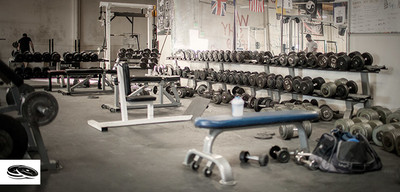When I walk into my gym, I often see familiar faces walking on the treadmills or methodically cranking away on the elliptical machines. When I finish my workout, these same people are still working the same equipment. And unfortunately, these people are usually still carrying the same body fat they had when I joined two years ago.
I can't help but shake my head. If you've been following the same program for months and you're not seeing any change. Why would you continue to follow the same exact program? You've no doubt heard Albert Einstein's quote about insanity, that it's doing the same thing over and over again and expecting different results. Watching the same bad television shows over and over again and expecting to wake up thin strikes me as equally cuckoo. I'm left wondering if "results" even factor into these individuals' mindsets anymore.
Personally, I can't think of anything more boring than endless low-intensity steady state cardio—especially inside a gym. I have the patience of a chipmunk, so if I had to spend an hour on one piece of cardio equipment, I'd probably tie a noose to the pull-up bar. Luckily, research has shown that steady-state cardio is not the best way to burn fat, and it may even eat away at your hard-earned muscle.
So what's the alternative? Don't drop the walking entirely. Instead, break it up with a few brief explosions of athleticism. It may not be fun at first, and your motivation will be tested to the limit. But ask yourself: Shouldn't training feel this way?
The Imperative For Greater Intensity
High-intensity interval training consists of short bursts of all-out effort alternated with short periods of low-effort "recovery" time. HIIT has been around for decades under different names and variations, but it raced to mainstream prominence in recent years thanks to a steady stream of research showcasing a host of benefits.
Interval training has been shown to burn fat while preserving muscle mass, increase circulating growth hormone in the body, greatly improve cardiovascular capacity, and increase the metabolic rate for hours or even days. But these don't even cover my favorite part about HIIT: that it can take less than 20 minutes.

It sounds like magic, and for this reason, all kinds of fit people have been recommending HIIT to all kinds of non-fit people. My message to novices: Don't jump in too quickly, because HIIT can be taxing on the central nervous system. Ease into it as you would if you returned to heavy lifting after an extended layoff. I also suggest no more than two HIIT sessions per week, especially if you're also hitting the weights hard.
Got that? Then let's fire the starting gun.
Option 1: Go On A Sprint-Walk

Sprint-walks are the classic example of HIIT training that can be done just about anywhere. If you have access to a track, you could sprint the straightaways and walk the curves. If a track isn't your style, just sprint in any direction and then walk back to the same starting point. I do this in the parking lot at my gym after my resistance work.
Warm your body up by running at a slow-to-medium pace for about 5 minutes. The sprint portions should last between 10-20 seconds, and the walk portion could last between 20 seconds and 2 minutes, depending on your fitness level and the progression of your training session. The walk portions tend to increase as the session unfolds.
If that sounds like a lot of timing and measuring, use the infrastructure to your advantage by running along a road. My running route has telephone poles spaced every 100 feet. I use them as my markers.
Three phone poles is roughly equivalent to a 100-yard dash, which takes me about 15 seconds (OK, so I'm not Usain Bolt, but neither are you). After that, I'll walk for a series of phone poles until I feel I can sprint again.
It's just as simple as it sounds, but use caution if you're not accustomed to sprinting. Sprinting is a dynamic movement that's notorious for causing injuries such as ankle sprains and tears of the Achilles tendon, hip flexor, and hamstrings (how many baseball players have you seen pulling up lame after legging out a hit?). Most muscle tears are a result of your CNS triggering a muscle to contract at the wrong time in a dynamic movement, so it's crucial to give your nervous system time to gradually adapt.
Accelerate in a controlled manor and avoid jackrabbit starts, especially on your first training session. Otherwise, you'll find yourself limping home mumbling all kinds of nasty things about me and my bright ideas.
Option 2: Sprint Up, Walk Down

At first, that hill may seem insurmountable, but once you reach the top and see how far you came, the fear dies. After that, you'll just want to climb it faster.
Step 1
Find a steep hill. You probably have one within a half-mile or so of your house, even if you've never noticed it. It doesn't have to be much. Walter Payton did sprints in a landfill for crying out loud, so keep an open mind.
Step 2
Jog to the hill and then run up it as fast as you can. You'll be warmed up by the time you reach the top. You might feel like you're barely able to imagine running it again, because hill sprints generate a tremendous pump in the legs, very quickly.
Step 3
Walk back down the hill and repeat as many times as you can. The great thing about hill sprints is that they dictate the pace of your run. After four repetitions, my heart always feels like it's going to burst out of my chest. The light jog back to your house is your cool-down.
Option 3: Ride the Machines

You might think that I'm going to advocate sprint-walks on a treadmill here, but honestly, I find that it's a pain to have to press the buttons and change the speed. Instead, I think intervals work best on machines where you set the pace, such as bikes or elliptical machines.
For interval training, ellipticals and bikes work better than treadmills; it's just easier to switch speeds.
If I use a stationary bike, I choose "Quick Start" and set the resistance to the highest level so it's difficult to pedal. After a warm-up of 5 minutes or so, I'll start my sprint phase by standing up and pedaling as fast as I can for 30 seconds.
Then I'll sit down and pedal for 30 seconds at a slow pace for my "walk" phase. There are many different sprint-rest combinations you can try, but I find that after 20 minutes of 30/30, my legs will be so pumped I can barely walk.
On an elliptical, again use "Quick Start" and increase the resistance. However, I recommend not holding the moving handles, because they limit your sprinting speed.
You can hold the stationary handles but I prefer not to hold on to anything, because it increases core activation and will improve your balance.
Again, perform 30 seconds of sprinting followed by 30 seconds at a slow pace. At the end of some of the "walk" phases, I'll come to a stop and reverse direction. You'll find that you can't sprint as fast in reverse, but it stresses your leg muscles in a much different manner.
Suffer And Love it
I've always been of the opinion that if you hate doing something, you won't do it for long, so you'd better find some way to do it that you don't hate quite so much. So yeah, HIIT has more benefits and it takes less time than traditional cardio, but if you're serious about it, prepare for a grueling workout.
At least you're in good company. Back in 1796 the French writer Madame de Stael was asked her opinion of steady-state cardio vs. HIIT, or something, and she simply stated "One must, in one's life, make a choice between boredom and suffering."

